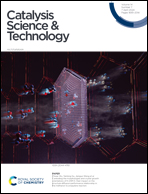Disordered medium-pore zeolite PST-24 as an efficient low-temperature isobutanol dehydration catalyst†
Abstract
The synthesis of PST-24 with a relatively high Al content (Si/Al = 47), a disordered medium-pore zeolite, using the seeding technique and its catalytic properties for the low-temperature (250 °C) dehydration of isobutanol to isobutene are presented. This PST-24 was found to be considerably more active and stable for isobutanol dehydration than H-ZSM-5 and H-ferrierite with similar Si/Al ratios, the two most widely studied catalysts for this reaction, revealing its high potential as a new dehydration catalyst for biomass-derived isobutanol. While variable-temperature IR spectroscopy with adsorbed isobutanol reveals stronger interactions of isobutanol molecules with the PST-24 framework than with the latter two zeolite frameworks, 1H–13C CP MAS spectroscopy shows the formation of soft coke only in the former catalyst.



 Please wait while we load your content...
Please wait while we load your content...